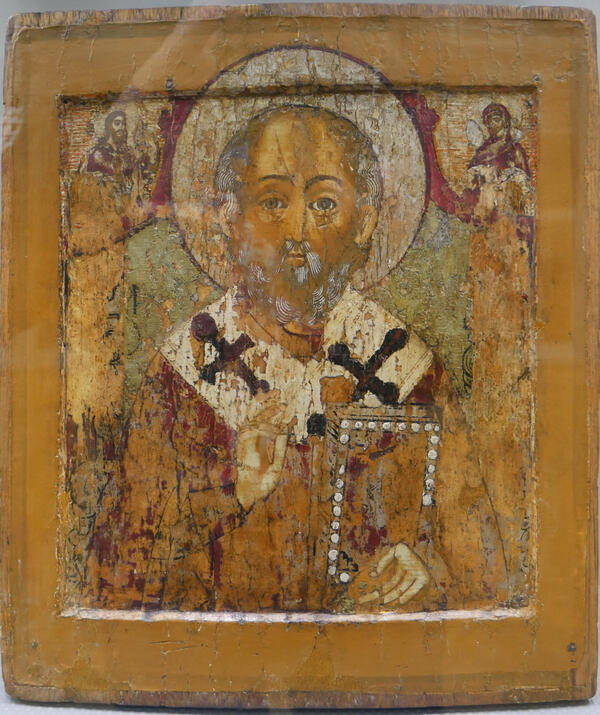The icon “Saint Nicholas the Wonderworker” entered the collection of the Murmansk Regional Art Museum after restoration in 1994, along with 50 icons found in the church of the Kovda village. The temple was closed for more than 30 years due to a state of disrepair. The icons from the collection date back to the period from the 17th to the 19th centuries and illustrate the most characteristic features and plots of iconography in the Russian North.
In the North, the image of Saint Nicholas is exceptionally popular. The widespread proverb “From Kholmogory to Kola there are thirty-three of Nikola” reflected the enormous popularity of the saint on the White Sea coast. Churches and chapels were built in honor of Saint Nicholas in almost every Pomor village. Nicholas the Wonderworker was the patron of those whose lives depended on the sea — sailors, fishermen, and hunters. They prayed in front of Saint Nicholas’s icons in church, at home, and in fishing huts. People took icons with the image of Saint Nicholas with them for long journeys.
There are many legends about Nicholas the Wonderworker. According to one of these legends, the Mongol hordes attacked Mozhaisk, one of the oldest towns in the Moscow region, in the 14th century. The local community addressed fervent prayers to Saint Nicholas. The saint appeared in the sky above one of the Mozhaisk churches. His appearance was formidable: in his right hand, he had a sword, and in his left hand, he held the town of Mozhaisk. Frightened by this formidable sign, the enemies fled in horror.
There are varied iconographic types of icons dedicated to Saint Nicholas. Half-length images of Saint Nicholas are among the most common ones. The saint is depicted in the vestments of a bishop, in his left hand he holds a closed Gospel decorated with white prints, symbolizing precious stones, he holds his right hand in a blessing gesture. Above his shoulders are half-length images of the Savior and the Virgin.
Most of the composition remains within the center of the icon (the recess), only the halo of the saint extends beyond into the margins. Despite the significant loss of the paint layer, there are remains of an olive background, saffron-colored fields, scarlet clothes with drapery lines that are barely visible, and decorative fragments in the lower part of the composition, indicating the icon painter’s desire to create aesthetic harmony.
In the North, the image of Saint Nicholas is exceptionally popular. The widespread proverb “From Kholmogory to Kola there are thirty-three of Nikola” reflected the enormous popularity of the saint on the White Sea coast. Churches and chapels were built in honor of Saint Nicholas in almost every Pomor village. Nicholas the Wonderworker was the patron of those whose lives depended on the sea — sailors, fishermen, and hunters. They prayed in front of Saint Nicholas’s icons in church, at home, and in fishing huts. People took icons with the image of Saint Nicholas with them for long journeys.
There are many legends about Nicholas the Wonderworker. According to one of these legends, the Mongol hordes attacked Mozhaisk, one of the oldest towns in the Moscow region, in the 14th century. The local community addressed fervent prayers to Saint Nicholas. The saint appeared in the sky above one of the Mozhaisk churches. His appearance was formidable: in his right hand, he had a sword, and in his left hand, he held the town of Mozhaisk. Frightened by this formidable sign, the enemies fled in horror.
There are varied iconographic types of icons dedicated to Saint Nicholas. Half-length images of Saint Nicholas are among the most common ones. The saint is depicted in the vestments of a bishop, in his left hand he holds a closed Gospel decorated with white prints, symbolizing precious stones, he holds his right hand in a blessing gesture. Above his shoulders are half-length images of the Savior and the Virgin.
Most of the composition remains within the center of the icon (the recess), only the halo of the saint extends beyond into the margins. Despite the significant loss of the paint layer, there are remains of an olive background, saffron-colored fields, scarlet clothes with drapery lines that are barely visible, and decorative fragments in the lower part of the composition, indicating the icon painter’s desire to create aesthetic harmony.


